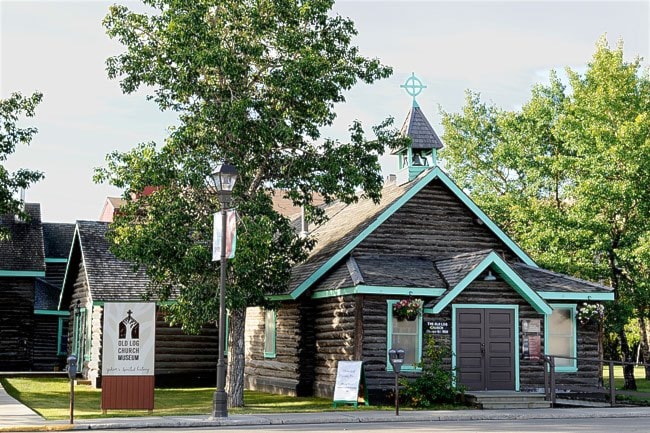UPDATED
Alene Peck might be up in her 90s, but she still remembers her wedding at the Old Log Church.
“I finished the school year and the next day we got married,” the former teacher said from her home in Fort St. John, B.C., recalling the brief time she spent working in the Yukon.
“Whitehorse was really small back then. We had a minister but there were only three or four people at the ceremony.”
The year was 1950 and the Old Log Church and Rectory were already 50 years old.
Whitehorse was on the cusp of becoming the territory’s capital, growing in size and importance.
More than six decades later, the Yukon Church Heritage Society board has nominated the buildings for heritage status, seeking to have them recognized at both the municipal and territorial levels.
Built in 1900, the buildings are intimately linked to the early development of the city.
At the turn of the 20th century, Anglican missionary William Carpenter Bompas was concerned with the lack of a place to worship in the community.
He enlisted the help of Reverend R. J. Bowen, a trained carpenter who had previously built log churches in Dawson City and Forty Mile, to rectify the situation.
After a brief bout with typhoid, Bompas came to Whitehorse on July 31, 1900 and set up work tents next to the church’s current site, in what is now Bishop Stringer Park.
With the community’s help, the single-storey log structure was completed by October and the first service was held on Sunday, Oct. 7.
A photographer captured the momentous occasion.
The black and white picture, showing a packed room filled with stern faces, can be seen today inside the museum, along with other artifacts from various eras.
Those include Reverend Bowen’s tools, his concertina and pictures of Queen Elizabeth’s visit in 1959.
The adjacent rectory was completed in 1901 and is still being used by the church for visiting clergy.
Over the years, both buildings have seen their foundations and roofs replaced, but the logs have aged well.
Linda Thistle, president of the heritage society, said the board has always felt the buildings were historic sites and deserving of heritage status.
“The church was the centre of community in those days and throughout the war years, when it was used by all denominations,” she said.
“Robert Service was the churchwarden for a while. Its use has been unbelievable.”
She estimates tens of thousands of tourists from all over the world have visited the site.
“Our joke at the museum is that if we had a dollar for every picture a tourist took of the church, we’d be all right,” she said with a laugh.
Last summer, the YCHS board began the process to have the buildings designated as historic sites.
They submitted applications to the city and to the Yukon government’s cultural services branch.
Thistle then gave a presentation at the church to the Yukon Heritage Resources Board, which was impressed by the fact that the buildings have been in almost continuous use since 1900.
They made a recommendation to Minister Mike Nixon, who approved the request.
The site will be recognized, provided there are no objections, by Sept. 30.
For city recognition, a public hearing will be held on Oct. 14 and a report read to council on Oct. 20.
Council will make a final decision on Oct. 28.
For more than 30 years, however, the board was under the impression the church and rectory were already considered historic sites.
In 1978 a huge crowd descended on the corner of Elliott Street and Third Avenue for a plaque unveiling ceremony, where the buildings were declared territorial historic sites.
The wheels were in motion for the paperwork to be completed, only to be interrupted by the election of the territory’s first responsible government.
When the Progressive Conservatives rose to power and formed the first party government of Yukon in 1979, the legislation was forever lost in the wind.
“We thought that maybe with the territorial government we should have been grandfathered,” Thistle said.
“But we weren’t, so when we realized the site wasn’t a historic one, we decided to dot our I’s and cross our t’s and get the process underway.”
If approved by the city, the buildings will join a group of 15 other recognized historic sites, including the Taylor House, the telegraph office and the Old Fire Hall.
Considerations are based on architectural history, cultural history, context, integrity and age, according to the city’s website.
Benefits of the designation include additional protection ensuring the buildings and grounds cannot be altered, and possibly access to more funding.
Board member Len Beecroft said an ongoing battle over the years has been to make people realize that the buildings are a lot more than just a church and rectory.
“They’re overlooking the fact that it’s a museum,” he said.
“It’s so much more than that.”
Contact Myles Dolphin at
myles@yukon-news.com
